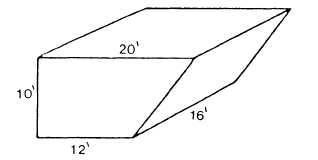| |
from the bulkhead along both the long sides of the space.
Also, a 30-inch passageway should be provided down
the center of the space. Study figure 12-5 and notice the
allowances that will have to be made for the coils and
passageway. In addition, the lights extend down 7 inches
from the overhead, and gratings 8 inches high were
placed on deck as shown in figure 12-5, the side view.
To find the cubical capacity of this storage space,
write down the actual dimensions of the space. Then
subtract the dimensions of the allowances you will need
to make, like this.
Using the new dimensions, proceed as before.
22 1/2 x 10 3/4 x 8 1/2 = 2,055 15/16 cubic feet.
You may have a storage space shaped like the one
shown in figure 12-6. First, you will have to get the
average width by adding the two widths together and
dividing by 2.
Then complete the problem by multiplying this
average width by the length and by the height.
16’ x 16’ x 10’= 2.560 cubic feet.
Special Space Problems
Some food items, such as frozen meats, should be
kept in a special type of storage. The capacity of these
spaces limits the amounts you may order.
When planning for an extended cruise, you may find
that freeze space on your ship is not adequate to store
the total meat requirements. You will want to load
Figure 12-6.-Irregular space.
canned meats to supplement your frozen meat supply.
The Table of Substitution Factors for Custom Foods lists
the factors to use when converting pounds of frozen
meat items to canned meat counterparts. This table can
be found in the NAVSUP P-486, volume I, appendix G.
REQUISITIONING FOOD ITEMS
GMs ashore and ships in port normally submit
requisitions for authorized food items found in the FSC
to the nearest naval supply support activity. Deployed
ships should submit requisitions to a store ship (AF),
combat store ship (AFS), fast combat store ship (AOE),
or other afloat activity. When normal sources are not
available, food items may be procured by transfer from
other military sources and the United States
Government departments. Food items such as fresh
dairy products and commercially prepared bakery
products, as authorized, normally are procured in the
United States by placement of delivery orders against
indefinite-type contracts. Material is taken up as a
receipt from purchase. Brand name contracts (Defense
Logistics Agency Supply Bulletin, SB10-500) are not
authorized for use in procuring food items for the GM.
Further information concerning sources of supply,
procurement, and local restrictions are contained in the
Procurement section of the NAVSUP P-486, volume 1.
The bulk of your food items will be procured by
submitting requisitions using the DOD Single Line Item
Requisition Document, DD Form 1348 or 1348m, or
applicable requisition documents as required by the
supply support activity.
Mechanized Method
Nonautomated activities receiving semiperishable
food items from a mechanized supply activity within the
United States are provided prepunched and interpreted
decks (computerized cards) of the DOD Single Line
Item Request Issue Document (Mechanical), DD Form
1348m, for all semiperishable food items authorized for
use in Navy GMs.
Automated customer activities do not receive
prepunched decks of DD Form 1348m from the supply
point. Such activities prepare their own requisitions.
Any requisitioner may choose to submit manually pre-
pared requisitions using the DD Single Line Item Re-
quisition System Document (Manual), DD Form 1348.
Supply activities with mark-sensing equipment may
vary local procedures as necessary for maximum usage
of mark-sensing capability. However, the requisition
cards should be of a type and format universally
acceptable to all mechanized activities.
12-8
|


